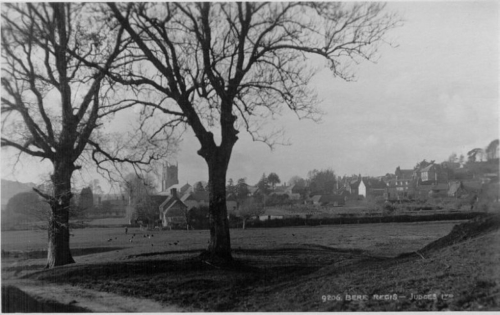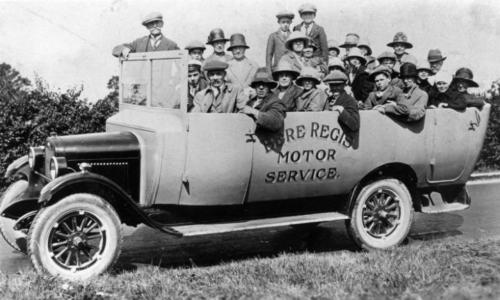Where the Bagshot beds thin out and terminate over the chalk, suitable brick clay is found in the parish and brick works became established at Brick Hill near Doddings and at Black Hill. The Brick Hill works, where the old Kiln still exists, was the older of the two, probably established at some time during the 18th century, and continued to function at least until 1911. The Black Hill works were probably established during the 19th century, and its kiln, drying platform with factory-like brick chimney, and even the railway lines and trucks remained on the site until the Second World War. Click the photo below to see the Brick Hill works in around 1885 -
There were a number of other small trades carried on in Bere Regis during the 19th century, details of which may be obtained from the census returns of 1841, 1851 and 1861 and the various trade directories already referred to, which appeared at approximately 5 yearly intervals from 1830 onwards. The following list of the numbers of people engaged in the various occupations, trades and professions is for 1851, a year which is fully covered by both a comprehensive directory and census returns. The occupations are in alphabetical order:
agricultural labourers ......... 186 laundresses ............... 10
baker ........................... 1 lime burner ..................1
barrister (a visitor) ............ 1 maltster .....................1
basket maker ..................... 1 masons .....................6
blacksmiths .................. 9 millers ..........,.......... 8
brewer ........................... 1 milliners ..................2
bricklayers ..................... 13 nurses ......,.,...........,3
brick makers ..................... 4 ostlers (and grooms) ...... 3
builders ........................ 2 physicians .........,..,.....2
butter factor ..................... 1 ploughboys .„.........„,29
butcher ...,.................... 1 plumber ..................... 1
button makers .................. 69 postmistress ....„.........1
carpenters ..................... 12 relieving officer .........,..1
carriers ........................ 2 road labourer .........,..,.,1
charwoman ..................... 1 road surveyor ..,.,..,......, 1
coachman ..................... 1 saddlers ...........„........3
confectioner .....„.......„.. 1 sawyers .....,.....,.....,..,2
cooks ........................... 2 scholars .....,.....,.....,.,110
coopers ........................ 4 schoolteachers ,..,...,..., 4
dairymen ........................ 3 servants .....,......,.„„„,31
draper .....................,..... 1 shepherds ....... 6
dressmakers ........,......... 15 shoemakers .........,...., 15
farmers ........................ 30 shopkeepers „........,.„,3
footmen ........................ 3 tailors ............,.„„„,7
gamekeepers .................. 3 tallowchandler .,.......„,1
grocers ........................ 6 thatchers ...„...,...„„„5
independent minister ......... 1 tinker ...,.....,.....„„„„,1
inland revenue officer ....„... 1 tinsmith ....,..„..,.„„„„1
innkeepers ..................„, 4 toll gate keepers ............ 2
ironmonger .................. 1 vicar .........,.,.„„„„„,1
joiners (and cabinet makers) 3 wagoners ...........,..„„7
knitter ...................,....... 1 woodmen .................. 34
The trade directory for 1851 gives the number of milliners as 7 against the 2 recorded in the census returns, but as they are all described as "milliner & c" in the directory they may have been dressmakers as well and included in that category for the purpose of the census. In fact it was by no means unusual during the 19th century for a person to have two or more trades as a kind of insurance against lean times in one or the other, and in some cases they are amusingly incongruous. For example in 1842 there were a "butcher & beer retailer," a "cabinet maker & beer retailer" and a "bricklayer & beer retailer," whilst in 1851 there were a "blacksmith, grocer and draper," a "farmer and road surveyor," a "grocer and ironmonger," a "grocer and cooper" and a "beer retailer & farmer." Perhaps the best combination appears in the directory for 1859 describing the proprietor of what is now the Central Stores:
Joseph Hamilton Mundell-grocer, ironmonger, bookseller, seedsman, vendor of patent medicines, & agent to the Eagle Life office.
The idea of selling both patent medicines and life insurance over the same counter was nothing less than inspired, and in the same year we get:
Thomas Satchell, drtiggist, grocer, painter, plumber & glazier.
In this case any connection there may have been between the trades is not so apparent.

















